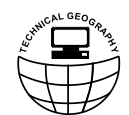Geographia Technica, Vol 20, Issue 2, 2025, pp. 190-204
PREDICTING EARTHQUAKE POTENTIAL THROUGH MORPHODEFORMATION MODELING USING SENTINEL-1A IMAGERY IN THE SINGKARAK SEGMENT, INDONESIA
Triyatno TRIYATNO  , Dipo CAESARIO
, Dipo CAESARIO  , Febriandi FEBRIANDI
, Febriandi FEBRIANDI  , Beni AULIA
, Beni AULIA  , Azhari SYARIEF
, Azhari SYARIEF 
ABSTRACT: This study aims to analyze geological and geomorphological conditions, develop a morphodeformation model, and predict potential magnitude, epicenter depth, and Peak Ground Acceleration (PGA) values in the Singkarak Segment, West Sumatra, Indonesia. The Singkarak Segment, intersected by the active Sumatran Great Fault and influenced by nearby Mount Marapi, exhibits high seismic risk due to its complex tectonic and volcanic settings. The research employed multi-phase spatial analysis using secondary data sources, including Sentinel-1A satellite imagery, Digital Elevation Model Nasional (DEMNAS), geological and geomorphological maps from the Indonesian Geospatial Information Agency, and seismic records from the United States Geological Survey (USGS). Morphodeformation was analyzed using Sentinel Application Platform (SNAP) for radar data processing. ArcGIS, including kriging interpolation and raster calculator, was used to model spatial variations in earthquake magnitude, epicenter depth, and PGA. Results showed denudational and fluvial landforms are most susceptible to seismic activity, with magnitudes ranging from 3.00 to 6.39 Mw and PGA values up to 368.83 gal. The highest magnitude events (≥6.0 Mw) and strongest ground accelerations were concentrated in central and southern zones. Morphodeformation analysis indicated vertical displacements of −0.52 to +0.20 mm (2019–2023) and increased activity in 2023–2024, with values ranging from −0.85 to +0.45 mm. Shallow epicenter depths (18.37–36.64 km) dominated the area, particularly within denudational and fluvial terrains. In conclusion, integrating geological, geomorphological, and deformation modeling confirms that the Singkarak Segment is an active and vulnerable seismic zone. The findings underscore the importance of incorporating morphodeformation and spatial modeling in earthquake risk mitigation, land-use planning, and infrastructure resilience in tectonically dynamic areas.
Keywords: Morphodeformation; Earthquake Hazard; PGA; Kriging; Singkarak Segment.

 Full article here
Full article here